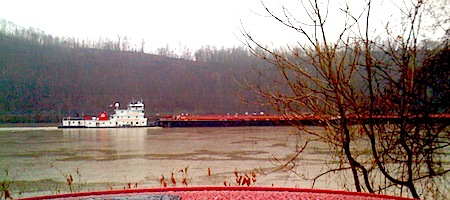
Last month, while nosing around the new Utica shale gas fields of eastern Ohio, I learned that the Obama administration was preparing to consider a proposal from the U.S. Coast Guard that would allow barge operators to transport wastewater from shale gas fracking operations on inland waterways. Earlier this month the Coast Guard delivered the proposal to the White House Office of Management and Budget. Sometime later this year the agency is likely to make the transport plan available for public review.
Regardless of the specifics, the idea that fracking wastewater ought to be considered a bulk commodity — like coal, gasoline, oil, cement, grain, chemicals and steel — reflects the expanding dimensions of the nation’s shale fields and the growing quantity of the contaminated water that the development produces. The river that very plainly will receive most of the attention in frackwater transport is the Ohio and its upriver tributaries, which drain nearly half of Pennsylvania’s watersheds, and most of eastern Ohio’s.
Thousands of deep shale gas wells are being drilled in both regions. Producing natural gas, and more valuable natural gas liquids, involves blasting the shale with millions of gallons of water mixed with chemicals and sand under extremely high pressure. Some three million to 10 million gallons go down the well. About 20 percent, according to industry technical reports, comes back up. And it’s nasty stuff — saturated with salts and metals and solids.
Water is the shale gas and shale oil industry’s soft underbelly. The companies knew that well before the fracking revolution started. During the early George W. Bush administration Vice President Dick Cheney convened meetings with industry executives who identified the federal Safe Drinking Water Act as an impediment to a swift start to horizontal drilling/fracking technology they believed would alter the nation’s energy outlook. The administration proposed and Congress quietly enacted waivers to the law that allowed the industry to keep the identities of the fracking chemicals secret and bypass permit requirements.
Citizens, though, took notice all over the country. Reports of leaks, groundwater contamination, and health consequences as a result of exposure to wastewater and drilling operations have become numerous. States have been roused to fill some of the safety gaps that the federal government avoided. Wyoming, Texas, and other states require companies to disclose the ingredients in their fracking fluid. Ohio and Pennsylvania issued tougher standards for constructing wells in an effort to prevent damage to drinking water.
The next big area of water concern is the sheer volume of wastewater. A new wing of the oilfield service industry, spurred by public concern, generated tougher standards that are leading to water recycling in Pennsylvania and Ohio. The competition for water during the deep 2011 and 2012 droughts in the interior prompted similar interest in Texas and Colorado for wastewater recycling. Halliburton, the big oilfield service company, is a leader in developing mobile recycling systems that clean up dirty water to a standard that makes it reusable for new frack jobs.
I crossed the path of a mobile recycling plant that Tervita operates for Chesapeake’s frack jobs in eastern Ohio. The plants save water, and reduce truck traffic. Solids separated from the wastes are said to be transported to local licensed dumps, though the Ohio Department of Natural Resources says it doesn’t track such shipments.
Most fracking wastewater is pumped down the hazardous waste injection wells that operate around the country. As to where fracking wastewater might be heading on barges? Probably not upriver on the Ohio. Two years ago Pennsylvania outlawed treating frack wastewater in public water treatment plants.
— Keith Schneider